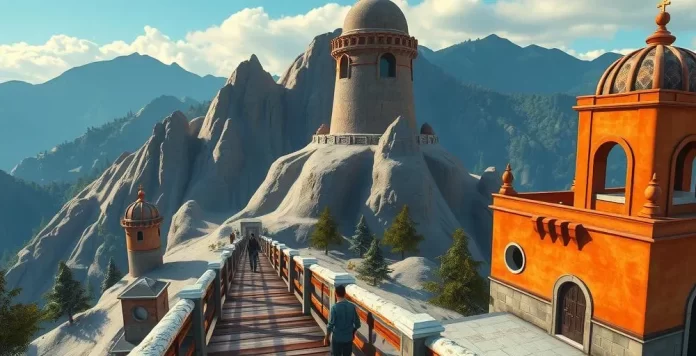It’s loads of fun to visit places you’ve always wished to go to, even in a virtual sense. Avid gamers can visit meticulously recreated real-world locations from the comfort of gaming chairs while sipping on a can of cola and snacking on nachos. From the bustling streets of New York City to ancient Egyptian ruins, the following games let us explore fab new places – and even the past – without suffering the pain of a long-haul flight or a packed train. It’s cheaper too, which is good if you need a new gaming rig.
Assassin’s Creed
The Assassin’s Creed franchise has done an awesome job of recreating places from history with breathtaking accuracy, like Assassin’s Creed II’s Renaissance-era Italy and Assassin’s Creed: Syndicate’s Victorian-era London where people lurk in gas-lamp-lit corners, and the developers spent tireless years working on researching architecture, culture, and daily life in order to create stunning worlds that have a truly lived-in quality.
Walking through ancient Rome in Brotherhood or climbing the pyramids in Origins is not just a fun gaming sesh – it’s playing virtual archaeology. The attention to detail is so remarkable that you can nearly smell the spices of the Egyptian bazaars or feel the Mediterranean breeze in your hair as you parkour across Florentine rooftops. Thankfully, they’re not so realistic that you have to smell the open drains or unwashed bodies in a crowded marketplace, because that would be a step too far. Nobody needs that. Ugh. Grim!
Kingdom Come: Deliverance
Kingdom Come: Deliverance offers one of the most faithful recreations of a real-world environment ever attempted in a game. Set in 15th-century Bohemia (now the Czech Republic), this RPG carefully recreates the countryside around Sázava, including genuine castles, villages, and landscapes that existed over 600 years ago. Who’d have believed it was possible to be this accurate!
What sets this super fun game apart is the painstaking attention to historical detail. The developers spent a lot of hours studying medieval life, consulting with historians and archaeologists to make sure everything from buildings to clothing was period-accurate. For anyone hoping to take a walk through the villages of Rattay or Uzhitz, your fairy godmother just waved her glittery wand – these aren’t fantasy versions but painstaking recreations drawn from historical documents and archaeological findings. Sure, you can’t actually go there because, sadly, time has moved on, but it’s the next best thing if we’re honest. And also less dangerous for those of us not skilled with a sword.
That said, a lot of the game’s settlements and castles are modelled on real locations that still exist today, albeit in a far different state than they appear in the game – as in crumbled and not functional. Sázava Monastery, however, one of the game’s central locations, is a real structure you can visit, making the connection between virtual and real-world exploration so much more fun if you fancy a trip away from your gaming cave.
Ghost of Tsushima
Ghost of Tsushima whisks you away to a breathtakingly beautiful recreation of 13th-century Japan, not long after the Mongol invasion. While the game is fictionalised from history (obviously), the island of Tsushima itself looks super real on a screen. Every swaying bamboo grove, silent temple, and steaming hot spring seems to have been plucked from a classical Japanese painting.
The Sucker Punch Productions team studied traditional Japanese architecture, landscaping, and art forms to create a world that honours the country’s aesthetic heritage, and the game’s photo mode is much talked about among players online in forums like Reddit who spend hours snapping images of the stunning landscapes.
Most remarkable is how the game captures the essence of rural Japan – the peaceful temples in the mountains and forests, the ancient villages with their tile roofs, and the rocky shores. It’s a love letter to Japan that will make you want to book a trip to the real Tsushima Island. Play it and pretend you’re a walk-on extra in some cool Netflix show.
Gaming Beyond Traditional Adventures
Virtual sightseeing isn’t limited to epic RPGs or open-world action games – plenty of other genres let you wander through lovingly crafted real-world-inspired locations. Even puzzle and simulation games often draw from genuine settings: think of Microsoft Flight Simulator giving you a pilot’s-eye view of cities across the globe, or GeoGuessr dropping you into a random street via Google Street View and challenging you to figure out where you are.
Even casino-style games have embraced the travel bug. Many new slots are designed around richly detailed recreations of famous destinations, from the marble temples of Ancient Greece to the neon-soaked boulevards of Las Vegas. They may not let you climb pyramids or sneak past guards, but they still deliver a taste of far-off places from the comfort of your couch.
The common thread is the joy of digital tourism – the thrill of seeing somewhere you’ve never been, whether it’s 5,000 miles away or 500 years in the past.
The Future of Virtual Tourism
Games like these show that virtual tourism is just as fun as paying a fortune for a flight ticket and hopping on a plane overseas – it’s a legitimate way to experience places and cultures, and whether your interest is history, architecture, or just satisfying your raging wanderlust, there’s probably a game out there that can scratch that non-mosquito-related travel itch while delivering an experience you’ll never forget. Unlike mosquito bites, which are really hard to forget.

